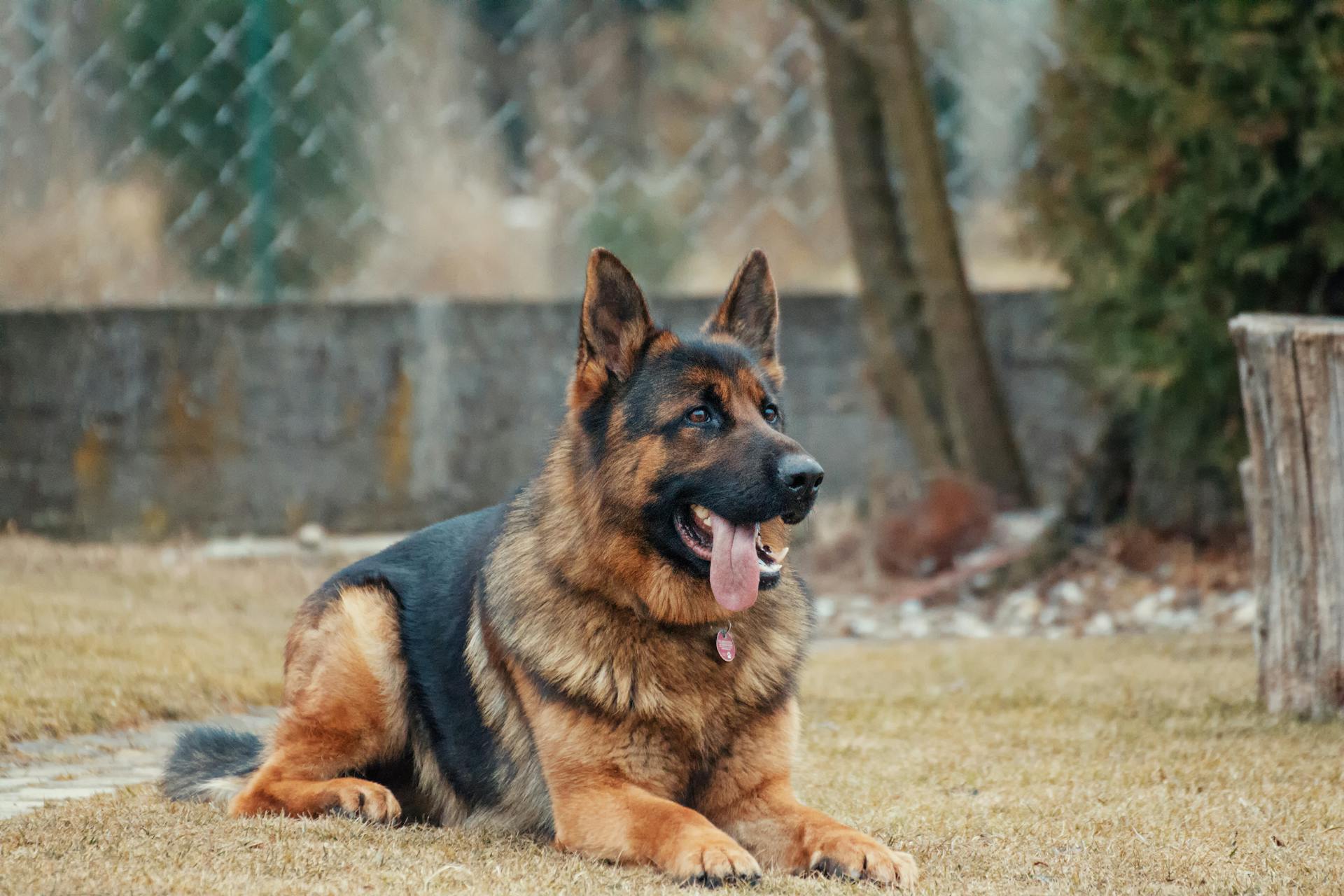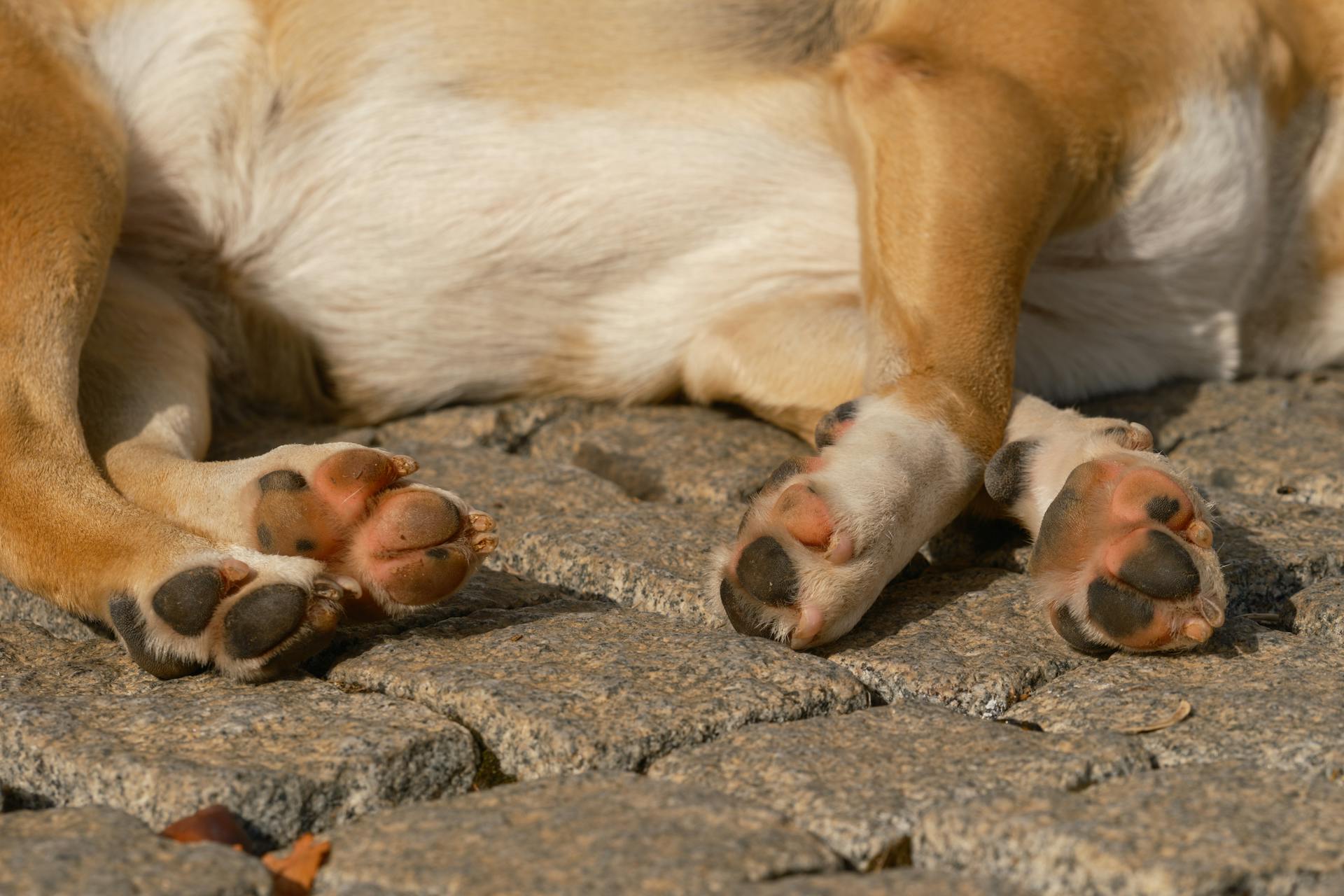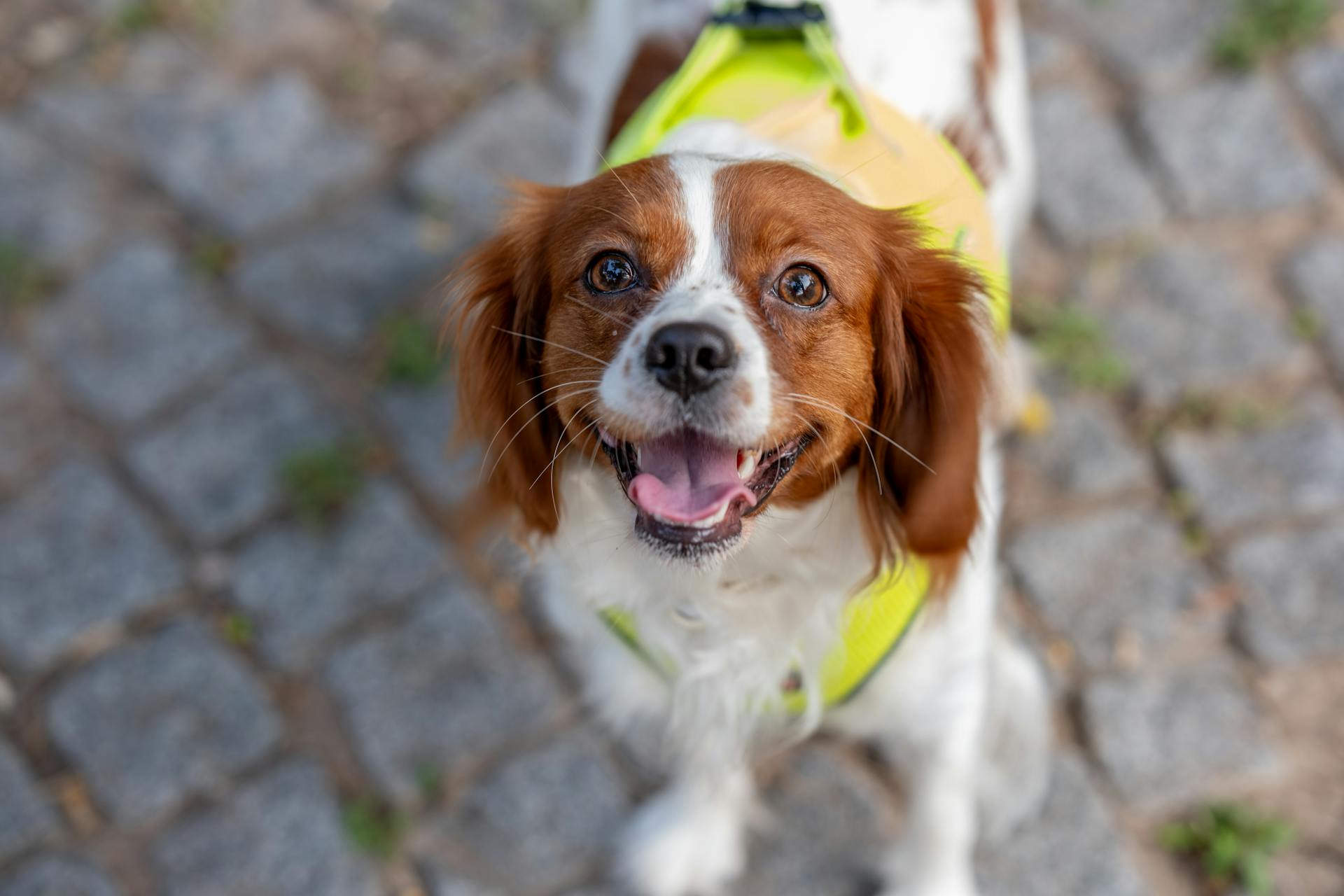
The canine skeletal anatomy system is a fascinating topic that's essential for any dog owner or enthusiast. The canine skeleton is composed of 319 bones, which is significantly more than the human skeleton's 206 bones.
Dogs have a unique skeletal system that's adapted for their specific body shape and function. The pelvis, for example, is designed to support the dog's weight and facilitate movement.
The canine skeletal system includes the axial skeleton, which consists of the skull, vertebral column, ribcage, and sternum. The appendicular skeleton, on the other hand, includes the limbs and girdles.
Skull
The skull is a vital part of a dog's skeletal anatomy, protecting the brain and head against injury and supporting the structures of the face.
The shape and size of the skull vary widely between different breeds of dog, with some having longer skull lengths and others having shorter ones. This variation is due to the different skull lengths of dolichocephalic, brachycephalic, and mesocephalic dogs.
In young animals, the skull is made up of many individual bones separated by narrow fibrous tissues or "sutures" that allow for growth. These sutures are a key feature of canine skeletal anatomy, enabling the skull to expand and change shape as the animal grows.
Occipital Bone
The occipital bone is the most caudal bone of the skull. It's a vital part of the skull's structure, providing attachment points for several important muscles and ligaments.
The external occipital protuberance is a key feature of the occipital bone, serving as the most caudal element found medially within the bone. It's a distinctive landmark that can be palpated in most canines, unless they're very well muscled.
The nuchal crests are located laterally on the occipital bone, while the sagittal crest is found medially and dorsally to the external occipital protuberance. The sagittal crest is quite prominent and can often be felt in most canines.
The nuchal wall is formed by the combination of the nuchal crests and the sagittal crest, along with the foramen magnum. This foramen is a critical opening in the occipital bone that allows for the passage of important nerves and blood vessels.
The occipital bone also has muscular tubercules on its ventral surface, which provide attachment points for the flexors of the head and neck. This is a crucial feature for canines, as it allows for flexibility and movement of the head and neck.
For more insights, see: Canine External Anatomy
The paracondylar process is another important feature of the occipital bone, providing muscle attachment sites for the muscles of the head. This process is a key landmark for understanding the skull's structure and function.
The hypoglossal canal is also located within the occipital bone, serving as a passage for important nerves that control the muscles of the tongue. This is a critical feature for canines, as it allows for proper tongue movement and function.
Broaden your view: Canine Tongue Anatomy
Maxilla
The maxilla is a vital part of the skull, forming most of the facial part, including the lateral walls of the face, nasal cavity, oral cavity, and hard palate.
It's the largest bone of the face, articulating with all of the facial bones. The maxillary body encloses the maxillary sinuses and forms the external surface of the face.
The maxilla also forms the facial crest and has a palpable infraorbital foramen. The conchal crest is located on the nasal surface, where the ventral nasal conchae attaches.
For another approach, see: Canine Nasal Cancer
The lacrimal canal opens into the lacrimal foramen on the nasal surface. The pterygopalatine surfaces are the caudal part of the maxilla, terminating in the maxillary tubercle.
The maxillary tubercle is where the sphenopalatine, maxillary, and caudal palatine foramen are present. The alveolar processes are separated by interalveolar septa.
The palatine process forms the hard palate with the palatine bone, creating the palatine fissure at the articulation with the incisive bone.
Take a look at this: Anatomy of Maxillary Canine
Mandible (Mandibula)
The mandible, also known as the mandibula, is a crucial part of the skull. It's divided into two main sections: the body and the ramus.
The body of the mandible supports the incisor teeth at the front and the cheek teeth at the back. The section without teeth is called the interalveolar margin or diastema. The mandible contains the mandibular canal and the mental foramen.
The facial notch is located on the underside of the mandible, where the facial vessels run. The ramus extends from the back of the body upwards towards the zygomatic arch. The masseter muscle attaches to the lateral surface at the masseteric fossa.
The medial pterygoid muscle attaches to the medial surface at the pterygoid fossa. The angle of the mandible terminates at the condylar process and the coronoid process, which are separated by the mandibular notch. The coronoid process is where the temporal muscle inserts.
Here's an interesting read: Canine Anatomy Muscles
Sternum
The sternum is a crucial bony structure in a dog's thoracic cavity, providing attachment for the ribs and an anchor for some of the muscles involved in respiration.
In canines, the sternum is composed of three elements: the manubrium, the body, and the xiphoid. The manubrium is rod-shaped and projects cranially to the first rib.
The body of the sternum is generally cylindrical in shape and is composed of numerous segments interconnected by the costochondral ventral aspects of the ribs.
These segments, referred to as sternebrae, are cartilaginous in young canines and ossify with age.
Vertebral Column
The vertebral column is a crucial part of a dog's skeletal anatomy, consisting of seven cervical vertebrae, thirteen thoracic vertebrae, seven lumbar vertebrae, three sacral vertebrae, and a variable number of caudal vertebrae.
Each vertebra has a unique shape and function, but they all share certain characteristics, such as a vertebral body, a vertebral arch, and a spinal process. The vertebral body is the main weight-bearing part of the vertebra, while the vertebral arch forms the posterior wall of the vertebral canal.
The vertebral column provides support, protection, and flexibility to the dog's body, allowing for a wide range of movements.
Sacral Vertebrae
The sacral vertebrae in dogs are located below the lumbar vertebrae and consist of three fused vertebrae.
These vertebrae are fused together to form a single bone called the sacrum, which plays a crucial role in transmitting the locomotive force generated by the hindlimbs to the dog's trunk.
The sacrum is a quadrilateral block, and in dogs, it usually consists of three fully fused vertebrae.
The articular joint between the sacrum and the pelvis is typically made up of one or two sacral vertebrae in dogs.
The sacrum narrows towards its caudal end and is curved to present a concave surface to the pelvic cavity.
The small spinous processes on the sacral vertebrae are retained in dogs, unlike in some other species such as pigs where they are absent.
You might like: Male Dogs Anatomy
Caudal Vertebrae
The caudal vertebrae are a fascinating part of the vertebral column. They originate from the caudal vertebrae of the sacrum and become progressively simplified in a caudal direction.
Initially, these vertebrae have a similar conformation to lumbar vertebrae, although they are smaller in overall size. They can vary significantly in number amongst individuals, breeds, and species.
The most caudal of these vertebrae are almost reduced to a rod shape, a remarkable transformation from their more complex beginnings. This variation in structure and number highlights the incredible diversity of the vertebral column.
Skeleton Structure
The skeleton is made up of three main parts: the appendicular skeleton, the axial skeleton, and the visceral skeleton. The appendicular skeleton includes the bones of the limbs, while the axial skeleton includes the bones of the skull, spine, ribs, and sternum.
The axial skeleton is further divided into different types of bones, such as flat bones, which are found in the pelvis and the head, and provide protection for the brain and other organs. The skull is a great example of a complex structure made up of flat bones.
The skeleton is also made up of different types of bones, including long bones, short bones, sesamoid bones, flat bones, and irregular bones. Long bones, such as those found in the limbs, are designed to support weight and movement.
Here are some examples of different types of bones and where they can be found:
The skeleton is made up of several layers of tissue, including the periosteum, a fibrous membrane that covers the outside of bone, and cortical bone, which is the firm, dense, outer layer of bone that bears much of the body's weight.
Pelvic Girdle
The pelvic girdle of canines is a marvel of evolutionary design. It allows the muscles of the pelvis floor to be displaced laterally over a wider area than in large animals.
This unique conformation of the ilium bones enables the abdominal muscles to work more efficiently, which is essential for faster locomotion and agility.
Forelimb
The forelimb, also known as the thoracic limb, is a vital part of a dog's skeletal anatomy. It contains the shoulder blade, shoulder joint, upper arm bone, elbow, forearm bones, wrist, foot bones, and toes.
Dogs tend to carry 60% of their weight in the thoracic limb, which can put a lot of stress on the joints, especially in sport and working dogs. This makes them more prone to impact-related injuries.
Additional reading: Canine Thoracic Limb Anatomy
Proximal Forelimb & Shoulder
The proximal forelimb is a crucial part of a dog's anatomy, and understanding its structure can help you appreciate the incredible capabilities of your furry friend.
The clavicle, or shoulder blade, is not strictly a bony structure in canines, but rather a fibrous area of tissue within the brachiocephalicus muscle. This unique anatomy is important to consider when discussing forelimb injuries or conditions.
Dogs tend to carry 60% of their weight in the thoracic limb, which includes the proximal forelimb, making it a high-risk area for impact-related injuries, especially in sport and working dogs. This is a sobering reminder of the importance of proper conditioning and care for our canine companions.
A fresh viewpoint: Dogs Ear Anatomy
The radius and ulna, two bones that make up the forearm, provide the connection between the proximal forelimb and the bony structures of the distal limb. The ulna is caudal to the radius proximally and then becomes lateral to the radius distally, allowing for a unique range of motion in the forelimb.
On a similar theme: Canine Forelimb Anatomy
Phalanges
The phalanges of the canine forelimb are a fascinating topic. In the canine, there are three phalanges: proximal, middle, and distal bones.
The proximal phalanx of the main digits (II - V) has a concave articular surface and a groove on the palmar border to accommodate the articular surface of the metacarpus. This is a clever design that allows for flexibility and movement.
The middle phalanx is roughly two-thirds the length of the proximal phalanx and has a sagittal ridge on its articular surface that articulates with the groove of the proximal phalanx. This unique feature enables smooth movement between the two bones.
The distal phalanx is made up of a cone-shaped ungual process with a distinct collar called the ungual crest. The deep ungual groove distal to the crest provides attachment for the proximal border of the claw.
Hindlimb
The hindlimb is a fascinating part of a dog's skeletal anatomy. It's made up of several key bones that work together to enable movement and support the body.
The most proximal bone of the hindlimb is the femur, a long bone that's curved in a medial direction to facilitate articulation with the pelvis. This curvature allows the femoral head to fit neatly into the acetabulum of the pelvis.
The femoral head is spherical in shape and has a central non-articular area called the fovea, through which the intracapsular ligament attaches. In canines, the fovea is central within the femoral head.
The greater trochanter is a bony process located lateral to the femoral head and gives rise to the extensor muscles of the hip, also known as the gluteal muscles. These muscles attach to the ischial tuber.
The lesser trochanter is another small bony protuberance located distal to the femoral head and medially, which gives insertion for the iliopsoas muscles.
Intriguing read: Canine Hindlimb Anatomy
As we move distally, the stifle joint allows articulation between the tibia, with the fibula running parallel to it and medial to the tibia. The tibia effectively excludes the fibula from articulating with the femur.
The tibia has two condyles that facilitate articulation with the femur, and these condyles are separated by a caudal popliteal notch that allows insertion of the popliteal muscle.
The tibial tuberosity is a large and prominent bony structure located on the cranial aspect of the tibia, which continues distally via the tibial crest that gradually reduces distally.
The distal point of the tibia has an articular surface called the cochlea, which facilitates movement with the trochlea of the talus. The cochlea has a central bony prominence flanked medially and laterally with grooves.
Here's an interesting read: Canine Tibia Anatomy
Frequently Asked Questions
How is a dog's skull different from a human's skull?
A dog's skull is smaller and more horizontal than a human's, with a protruding nose area, whereas the human skull is larger and sits upright to accommodate a larger brain. This unique skull structure is just one of the many fascinating differences between humans and dogs.
Do dogs have the same bones as humans?
No, dogs have more bones than humans, with approximately 320 bones compared to humans' 206. The extra bones in dogs are mainly due to their extra teeth and vertebrae.
Sources
- https://en.wikivet.net/Bones_-_Dog_Anatomy
- https://www.petplace.com/article/dogs/pet-health/structure-and-function-of-the-skeleton-in-dogs
- https://benefabproducts.com/blogs/blog/a-dog-owner-s-guide-to-canine-anatomy
- https://canineconditioningcoach.com/canine-anatomy-terms/
- https://canineanatomyforbeginners.wordpress.com/skeletal-system/
Featured Images: pexels.com


